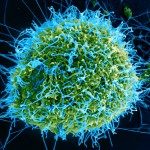Link to Pubmed [PMID] – 19020824
Methods Mol. Biol. 2009;485:151-9
Imaging studies have benefited from the development of a novel technique for non-destructive labeling of proteins within living cells, based on the use of a reagent called FlAsH-EDT2, a bisarsenical derivative of fluorescein capable of binding with high affinity and specificity to a tetracysteine motif in the protein of interest. This technique has been adapted for the stable, sensitive and specific molecular tagging of HIV-1 IN enabling the tracking of incoming viral particles inside infected living cells. Here we present the experimental steps required for the efficient labeling of HIV-1 IN, namely, molecular insertion of a tetracysteine tag, production of viruses, labeling in vitro of tagged viruses, infection of target cells and visualization of particles by fluorescence microscopy.

